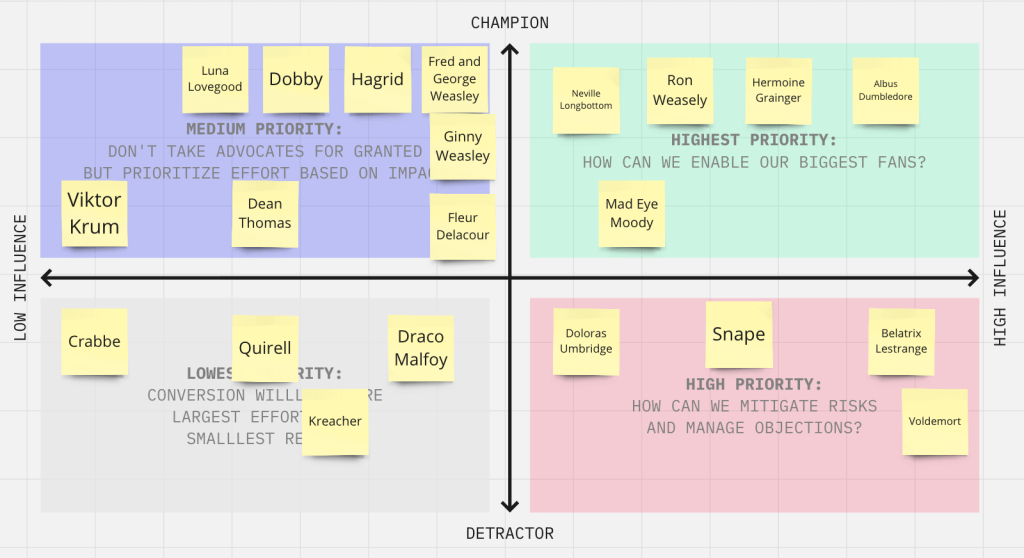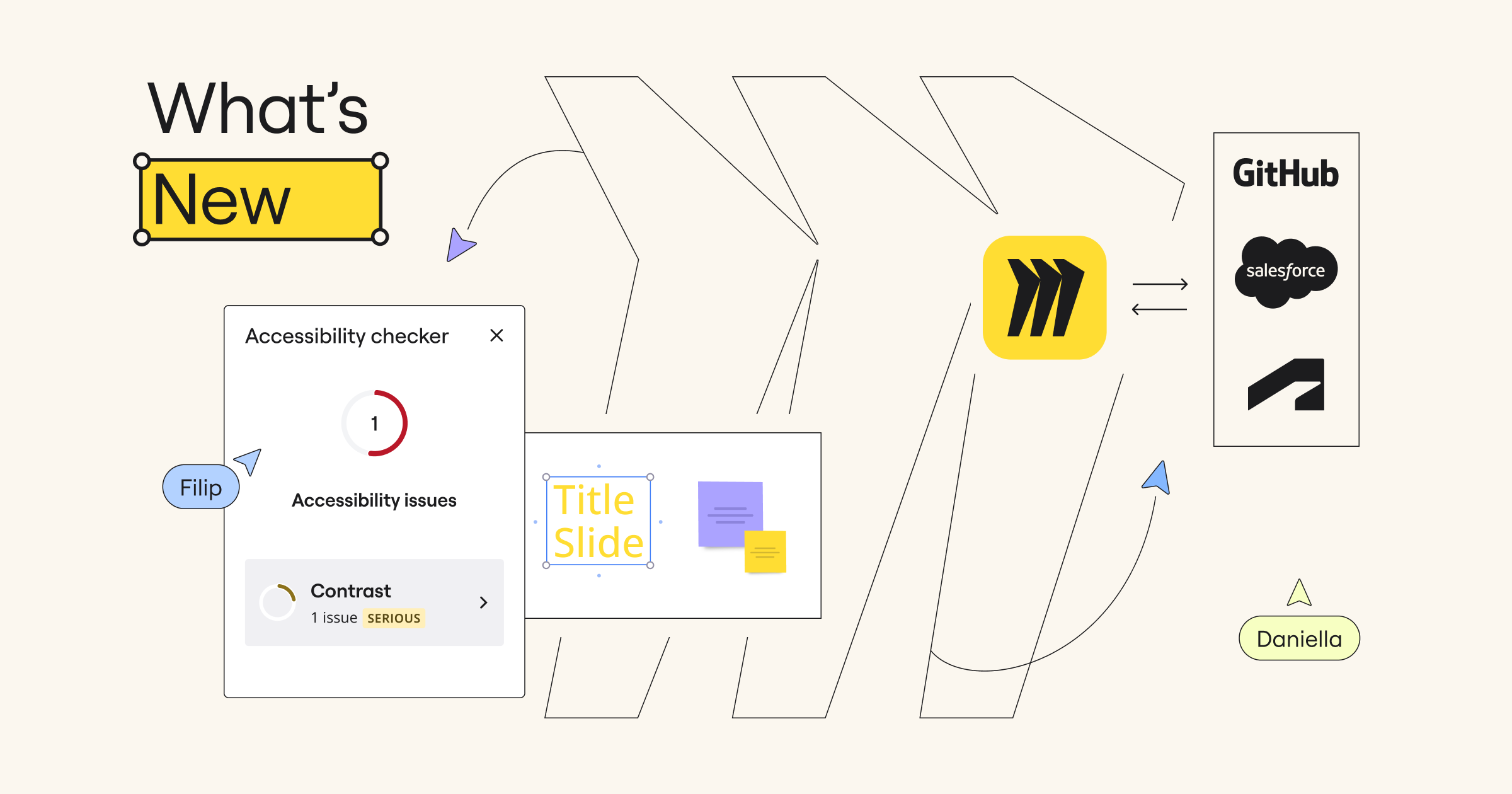Nailing Jell-O to a wall. Playing telephone…
You’ve probably heard these sayings before. But if you’ve ever been tasked with leading stakeholder management for a project, you know those phrases are more than just funny idioms — in most cases, they adequately describe the headache-inducing process of managing your stakeholders.
What exactly is stakeholder management?
Before you can grasp what stakeholder management is, you first need to understand the meaning of “stakeholder.” It’s a buzzword that gets thrown a lot and likely inspires visions of stuffy boardrooms and high-stress corporate environments. In reality, a stakeholder is simply anyone who has an investment, share, or interest in your project. In other words, they “hold” a “stake” in what you’re working on.
That could mean someone who’s actively involved in working on the project as well as anyone who could be impacted by the outcome of the project. Your stakeholders can be employees, leaders, investors, customers, board members, vendors… you get the idea.
So, your stakeholders are all of the people who have a vested interest or involvement in your work. That means stakeholder management is the process of identifying those people, keeping them adequately informed, and maintaining solid, trusting relationships with them.
High stakes of stakeholder management: Why it’s important
Needless to say, it’s easier said than done — particularly when stakeholder management is only one of your responsibilities (there’s still the actual project work itself, after all). Yet, prioritizing effective stakeholder management offers several compelling benefits:
- COLLABORATE MORE EFFECTIVELY: While a stakeholder might sound passive, they’re not always on the sidelines. Many times, you’ll need their active involvement or contribution — whether you need resources from another department head or insight from a company adviser. It’s far easier to get that when people already feel informed and engaged.
- BUILD STRONGER RELATIONSHIPS: Project success doesn’t hinge on processes and protocols — it depends on people. When you focus on establishing and maintaining strong bonds with the people who are closely tied to your work, you forge connections that benefit not only this specific project but also your future career.
- MITIGATE CONFLICTS: Projects usually involve a lot of different personalities and communication styles, which means they’re no stranger to conflict and finger pointing. Unsurprisingly, poor communication is the number one cause of conflict. So, the more successful you are at keeping your stakeholders in the loop, the less rocky the road will be.
- BENEFIT FROM MORE BRAIN POWER: Your stakeholders aren’t a burden — they’re a resource. They all have their own unique experiences and strengths that can be an asset to your project, provided you’re able to leverage them. When you effectively involve, engage, and manage your stakeholders, you’re in a better position to get their most helpful advice and guidance as they’re already up-to-date on your project.
Solid relationships, smoother collaboration, less conflict, and diverse perspectives are all wrapped up in the biggest advantage of successful stakeholder management: improved performance.
With the right stakeholder management strategy, you can spend less energy acting as a go-between or a mediator and more energy on what matters most: the actual project.
3-step framework for effective stakeholder management
Stakeholder management is important, but it’s also…well, hard. It often means juggling different priorities, perceptions, communication styles, preferences, levels of involvement, and even timezones — it’s enough to make any project manager break into a sweat.
We won’t sugarcoat it: stakeholder management is complicated. But this three-step framework helps simplify the process in a way that feels more doable.
1. Identify your stakeholders
Should I include this person on this email? I’ll copy them just in case. I’ll invite everybody to this meeting and see who shows up. I’ll just let this person know once the project is done.
Sound familiar? It’s easy to take a slapdash or best-guess approach to stakeholder management, particularly if you skip the crucial yet often overlooked first step: identifying your stakeholders.
Sure, this likely begins with a list of names — you need to determine all of the people who should be kept informed about your project progress. But simply creating a roster isn’t enough. One person on that list might be elbow-deep in the project and have to attend every meeting while another might only need a monthly update.
That’s why you need to dig deeper when identifying your stakeholders to not only understand who they are but where they fit in. There are several helpful stakeholder mapping tools you can use to do this:
- STAKEHOLDER MAP TEMPLATES: Identify all of your stakeholders and then categorize them based on who’s part of the core team, who’s involved, and who needs to be kept informed.
- STAKEHOLDER RACI MAP TEMPLATE: Similarly to the above, this map sorts your stakeholders — but this one uses their level of responsibility as opposed to their level of involvement. You’ll sort them into separate rings to figure out who’s responsible, accountable, consulted, and informed.
In short, it’s not enough to know the names of your stakeholders — you also need to understand their roles in your project.
2. Prioritize your stakeholders
Stakeholders are all different. That’s ultimately what makes them beneficial, but also challenging to manage.
Some might be your biggest advocates and cheerleaders. They’re ready and raring to champion your project. Others might be skeptical or even aggravated by your need for their involvement. And then there are plenty in between those two extremes.
Once you know who your stakeholders are and how they fit into your project team, it’s time to do something that feels maybe a little counterintuitive: determine who deserves most of your attention.
This might feel like playing favorites, but any sort of solid strategy is one that recognizes you can’t do everything at once. Prioritizing your stakeholders means you’re able to analyze which ones have the most influence and potentially the highest impact on your project. Those are the ones that warrant the majority of your focus.
This stakeholder management template is a helpful tool for doing this sort of stakeholder analysis in a logical and orderly way. With this matrix, you sort your stakeholders into the following quadrants:
- LOW INFLUENCE, CHAMPION: Excited about your project but don’t have a lot of influence
- HIGH INFLUENCE, CHAMPION: Excited about your project and have a lot of influence
- LOW INFLUENCE, DETRACTOR: Skeptical about your project but don’t have a lot of influence
- HIGH INFLUENCE, DETRACTOR: Skeptical about your project and have a lot of influence
When you have them sorted, you’re better equipped to take action in a strategic way. Generally, here’s how your prioritization shakes out:
- LOW INFLUENCE, CHAMPION: Medium priority
- HIGH INFLUENCE, CHAMPION: Highest priority
- LOW INFLUENCE, DETRACTOR: Lowest priority
- HIGH INFLUENCE, DETRACTOR: High priority
Particularly when you feel spread thin, having a resource that helps you understand where your stakeholders “rank” will help you focus your efforts on the people that are the most meaningful to your project’s success.

Try this Stakeholder Management template
3. Create a stakeholder strategy
Now it’s time to actually get into the management of your stakeholders — most of which hinges on your stakeholder communications plan. This is your blueprint for how you’ll actually keep your stakeholders informed and in the loop.
How you choose to approach this is up to you. You could create a plan for each of the “categories” you identified in the previous step. For example, establish a communications strategy for “high influence, champion” stakeholders that’s separate from the one you use for detractors.
Regardless of how you choose to break this up, your communications plan should detail things like:
- FREQUENCY: How often will you communicate with these stakeholders?
- METHODS: What communication channels will you use to communicate with these stakeholders?
- OWNER: Who is responsible for communicating with these stakeholders?
Some of these things can shift as you learn more about your stakeholders and their unique preferences. For example, some stakeholders might prefer email over Zoom meetings or another might let you know that they don’t need the weekly recaps and a monthly update would suffice.
While accommodating those individual requests is helpful for keeping stakeholders happy, be mindful that you don’t agree to so many specialized demands that communicating with stakeholders becomes unmanageable. You don’t want every single conversation to have to be highly-individualized.
Similarly, as you iron out your stakeholder communications plan, it can also be helpful to establish some communication rituals that you’ll stick with. These are recurring, predictable practices you’ll use to keep stakeholders informed, such as:
- Daily team meetings
- Weekly recap emails
- Monthly summaries
Not every stakeholder will need to be involved in every ritual. But establishing some of these communication conventions can be a great way to reliably communicate with a lot of stakeholders — without needing to have dozens of individualized conversations.
3 (more) practical stakeholder management tips
The above framework will help you tackle stakeholder management in a less daunting way, but here are three more tips to manage your stakeholders with more strategy and less stress.
1. Align your goals
Stakeholders don’t only have lofty ambitions — they often have competing ones. You’ve likely experienced it before. For example, one person wants it done perfectly and another wants it done fast.
It’s tough to keep your project moving forward if everybody’s running in eight different directions, which is why it’s so important to ensure everybody is aligned on the project’s goal and success metrics.
You can use OKR templates (objectives and key results) to ensure all of your stakeholders are on the same page about where the project is headed (and how you’ll know when you get there).

2. Create a single source of truth
Silos are another cause of rifts among stakeholders and project team members. It’s hard for them to see the forest when their faces are smashed against a tree. And sometimes they might be dealing with outdated or even inaccurate information.
That’s why it’s little surprise that research shows transparency is a crucial part of stakeholder management. One of the best ways to give your stakeholders a high level of visibility is to create a single, centralized source of truth for your project.
This could be something as simple as a weekly update email, a shared Google Doc, or a Miro board where you track progress and provide updates. It ensures everybody is getting the same overview and also gives stakeholders a stronger sense of ownership and involvement in the project.
3. Focus on trust
One of the best ways to maintain strong stakeholder relationships actually applies to any type of relationship: do what you say you’re going to do.
That might sound deceptively simple, but trust is crucial for stakeholder relationships and business performance. And your stakeholders can’t trust you if you’re repeatedly shirking responsibility and bailing on agreed-upon expectations.
Trust also breeds a high degree of psychological safety on your team and amongst your stakeholders, which means people will be more comfortable bringing information to you. Whether they’ve spotted a potential project risk or experienced someone trying to deviate from the project plan, trust means that all of your stakeholders will feel empowered to openly communicate with you.
Make no mistake(holder)
When it comes to planning and overseeing projects, stakeholder management often doesn’t get the attention it deserves. Many make the mistake of assuming it’s something that will just naturally happen as the work progresses — everybody will figure it out.
But it’s never too long before you have a mess on your hands and confusion, competing interests, and conflicts abound.
Much like your project itself, your approach to stakeholder management deserves some careful thought, strategy, and planning. Put the above framework and tips to work and you’ll handle stakeholder management in a way that hopefully feels a little less like herding cats and a little more like leading ducks.
Stakeholder management checklist
Stakeholder management isn’t a one-and-done activity — it’s a priority that extends through your entire project (and even after your project crosses the finish line).
Feeling overwhelmed? This quick checklist breaks down what to do with your stakeholders at each stage of your project.
PLANNING THE PROJECT:
- Identify your stakeholders
- Use a stakeholder map to understand your stakeholders’ roles
- Prioritize your stakeholders
- Create your stakeholder communications plan
- Establish your communication rituals
EXECUTING THE PROJECT:
- Create a single source of truth for your stakeholders
- Align stakeholders on your project goal and communication rituals
- Fulfill your promises to maintain trust with stakeholders
- Carry out your communications plan
- Check in frequently, particularly with high-impact stakeholders
WRAPPING UP THE PROJECT:
- Share final deliverables with stakeholders
- Communicate results and metrics to stakeholders
- Ask stakeholders for feedback
- Identify improvements for the next time you manage stakeholders
COLLABORATE AND INNOVATE WITH MIRO’S ONLINE WORKSPACE — LEARN MORE!




